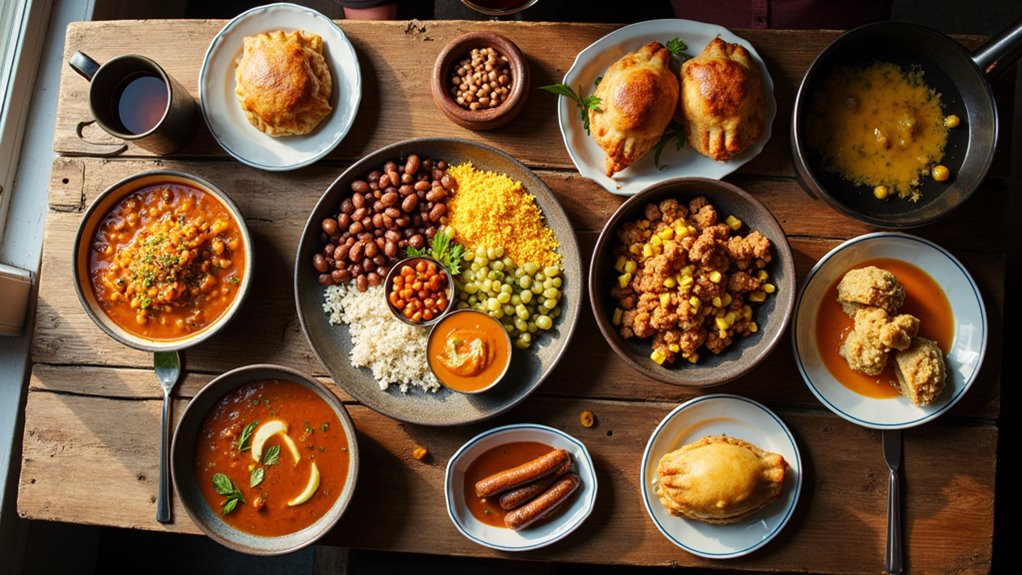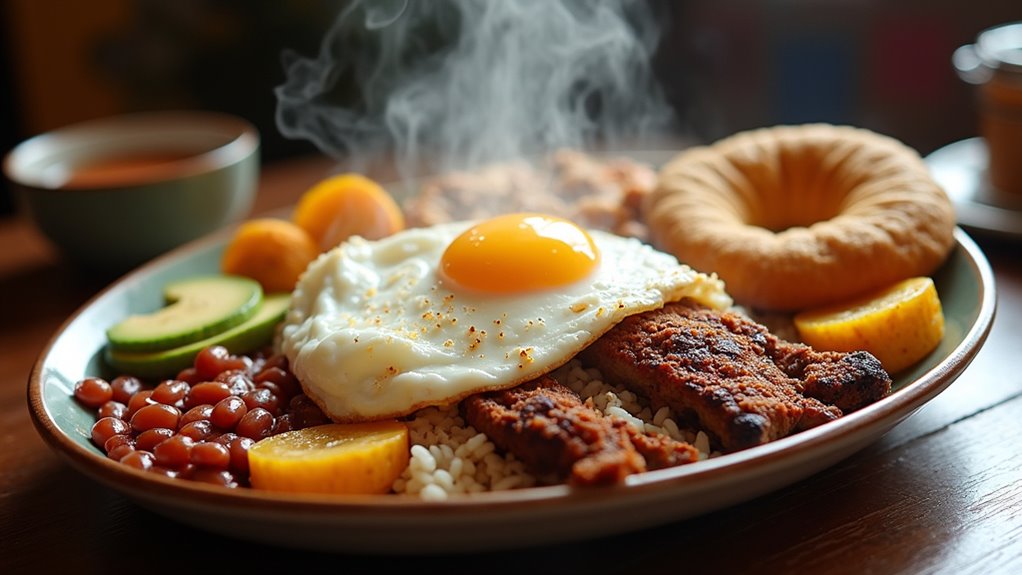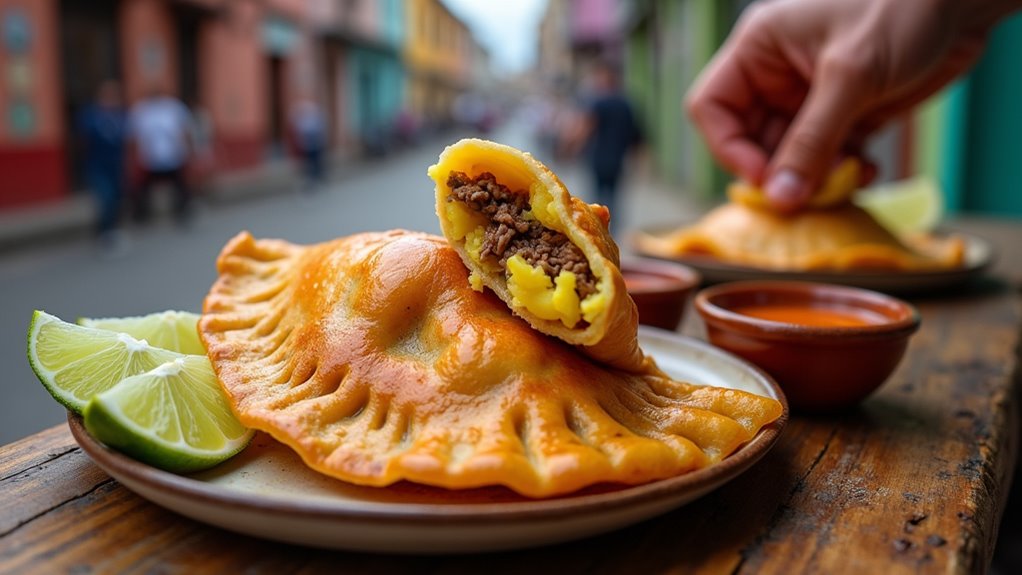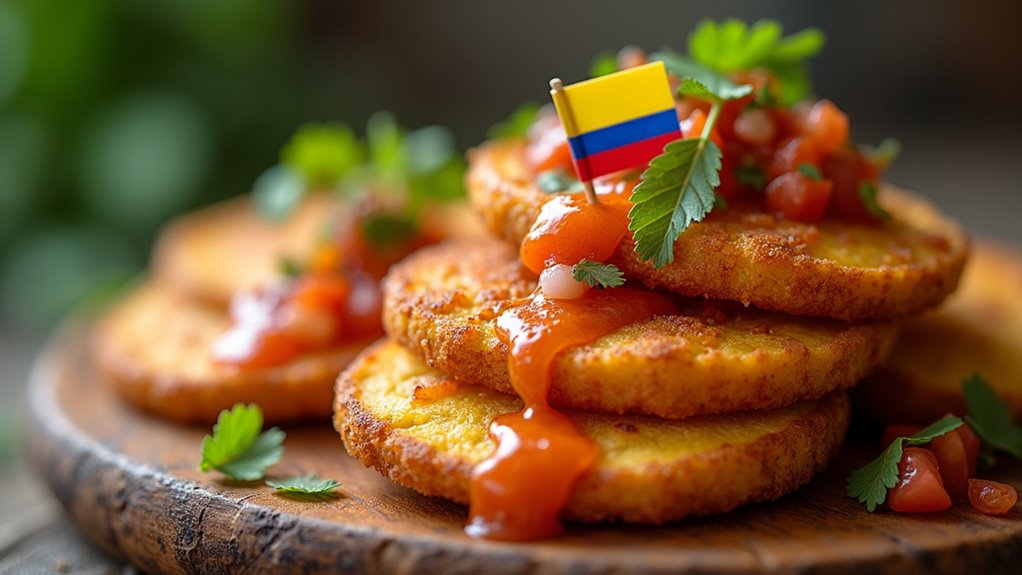Physical Address
304 North Cardinal St.
Dorchester Center, MA 02124
Physical Address
304 North Cardinal St.
Dorchester Center, MA 02124

Taste Colombia's gastronomic treasures through nine local dishes that blend indigenous, Spanish, and African culinary influences.
Colombian cuisine offers a delicious journey through diverse regional flavors. You’ll find hearty Bandeja Paisa loaded with proteins and sides, versatile corn-based Arepas, and comforting soups like Ajiaco and Sancocho. Don’t miss crispy Empanadas, celebratory Lechona, twice-fried Patacones with Hogao sauce, coconut-infused Arroz con Coco, and cheesy breakfast treats like Buñuelos and Pandebono. These nine dishes showcase Colombia’s opulent culinary heritage that blends indigenous, Spanish, and African influences. Let’s explore each unique dish in detail.

While many countries boast a signature dish, Colombia’s bandeja paisa stands as the ultimate expression of the nation’s culinary identity. Originating from the Andean Antioquia region, this robust platter combines white rice, red beans, two proteins (typically chorizo and beef), crispy chicharrón, fried egg, plantain, avocado, and arepa.
You’ll find this dish served during special occasions and family gatherings, representing Colombian hospitality and abundance. The dish is commonly shared in social settings worldwide, connecting Colombians to their heritage whether at home or abroad. The preparation is methodical—beans and beef are prepared a day ahead, while chicharrón, eggs, and plantains are cooked fresh before serving.
Regional variations exist throughout Colombia, with coastal areas incorporating fish and Tolima substituting French fries for plantains. Whatever the variation, bandeja paisa remains more than just food—it’s a cultural institution reflecting the country’s generous spirit.
At the heart of Colombian cuisine stands the arepa, a versatile corn cake that transcends mere sustenance to become a cultural cornerstone. Made from pre-cooked cornmeal (masarepa), water, salt, and butter, these golden discs are kneaded, rested, and then grilled, fried, or baked to perfection.
You’ll find endless regional variations throughout Colombia. The traditional cooking method requires slow, low heat to ensure the arepas cook thoroughly without burning the exterior. Try arepas de choclo, sweet corn cakes often stuffed with cheese, or sample arepas topped with hogao, a traditional onion-tomato sauce.
For heartier options, look for arepas filled with chorizo or egg.
Originally prepared by pounding dried corn in a pilón, modern arepas now embrace innovative fillings like avocado and pulled pork. Whether enjoyed at family gatherings or purchased from street vendors, these humble corn cakes represent Colombia’s prosperous culinary heritage.

From the misty highlands of Bogotá comes ajiaco bogotano, a hearty soup that embodies Colombia’s Andean soul. This centuries-old dish combines three varieties of potatoes that break down to create a naturally thick, creamy texture without added thickeners. The traditional preparation requires at least 2-4 hours of simmering to develop its rich, complex flavors.
What makes ajiaco special:
You’ll find this emblematic soup at family gatherings and special occasions throughout Colombia. While variations exist across regions, authentic ajiaco requires guascas herb—the element that connects this dish to its indigenous roots and makes it uniquely Colombian.
Typically served on Sundays and holidays, sancocho stands as Colombia’s ultimate communal stew. This hearty dish combines various meats (chicken, beef, or pork) with a colorful array of vegetables including yuca, plantains, corn, and potatoes.
Sancocho brings Colombian families together through a rich medley of meats and vegetables, savored slowly on special occasions.
You’ll find distinct regional variations across Colombia. The Antioqueño version features beef and pork, while coastal regions offer Sancocho Costeño with fresh seafood. Each variation reflects local ingredients and cultural influences.
The preparation requires patience—meats and vegetables simmer slowly in a large pot seasoned with cumin, cilantro, and achiote. When ready, it’s served in earthenware bowls garnished with fresh herbs. Authentically, many Colombian families prepare this beloved dish in large pots over an open fire, enhancing its rustic flavor and cultural significance.
Beyond nutrition, sancocho symbolizes unity in Colombian culture. When you’re invited to share this stew, you’re experiencing an authentic tradition that brings families together.

Colombia’s most recognizable hand-held treat, empanadas Colombianas, feature a distinctive corn flour dough that sets them apart from other Latin American versions. These crispy golden pockets are filled with a savory mixture of ground meat, potatoes, and Latin spices, then fried until perfectly crunchy. For an authentic Colombian experience, serve these empanadas with traditional ají colombiano and fresh lime wedges.
Try them with a variety of sauces for an authentic Colombian snacking experience.
When Colombians gather for major celebrations, lechona Tolimense often takes center stage as the showstopping feast. This impressive dish features a whole pig stuffed with rice, peas, and aromatic spices like cumin, pennyroyal, and dill, then slow-cooked for 10-12 hours in a brick oven until the skin turns perfectly crispy.
You’ll find this dish served at special occasions from Noche Buena to New Year’s Eve, where it symbolizes hospitality and brings communities together. Each region adds its own twist with local ingredients, making the Tolimense version distinct from Antioquia’s Paisa variation. For those with smaller gatherings, many families prepare scaled-down versions that maintain the dish’s rich flavors while being more manageable to cook.
Typically served family-style alongside arepas, hogao sauce, and spicy ají, lechona’s pre-colonial roots blend with Spanish influences, creating a cultural icon that’s evolved over centuries while maintaining its celebratory essence.

Among Colombia’s most beloved street foods, patacones con hogao showcase the perfect marriage of textures and flavors in Colombian cuisine. You’ll find these twice-fried green plantain discs served with a savory tomato-onion sauce in homes and restaurants throughout the country.
To appreciate this dish fully:
Whether served as an appetizer or side dish, patacones con hogao reflects Colombia’s culinary ingenuity in transforming simple ingredients into irresistible comfort food.
Venturing from the savory plantain treats of the interior, we now explore the coconut-infused magic from Colombia’s Caribbean coast. This rice dish showcases the region’s distinct culinary identity, blending sweet and savory elements into a satisfying side.
You’ll find arroz con coco prepared with long-grain rice cooked in coconut milk until fluffy, often with a touch of sugar for sweetness. The careful reduction of heat after boiling prevents burning while developing its characteristic flavor. The dish gets its distinctive rich color and depth from toasted coconut solids that are browned until golden.
Some variations include raisins or brown sugar for added depth.
At approximately 160 calories per serving, this vegan-friendly dish provides carbohydrates and moderate fat content. It’s particularly popular during family gatherings along Colombia’s coastal regions, reflecting the strong Caribbean influence that defines this part of Colombian cuisine.

While traveling through Colombia, you’ll quickly discover that breakfast often revolves around two iconic cheese-based treats: buñuelos and pandebono. These cheesy delights showcase Colombia’s masterful use of cassava flour and local cheese traditions.
Experience Colombia’s breakfast ritual with buñuelos and pandebono, where cheese and cassava craft unforgettable morning memories.
The key difference: buñuelos are fried for crunch while pandebono is baked for softness. Both are best enjoyed fresh and warm, making them perfect companions for your Colombian coffee experience.
Just as explorers navigate uncharted territories, you’ll discover Colombia’s soul through its diverse dishes. Each bite’s a passport stamp, revealing regional history and family traditions. Don’t just travel Colombia—taste it. From mountain-born Ajiaco to coastal Arroz con Coco, these nine dishes aren’t mere food—they’re cultural storytellers. Pack your appetite and plunge into; your culinary expedition awaits.